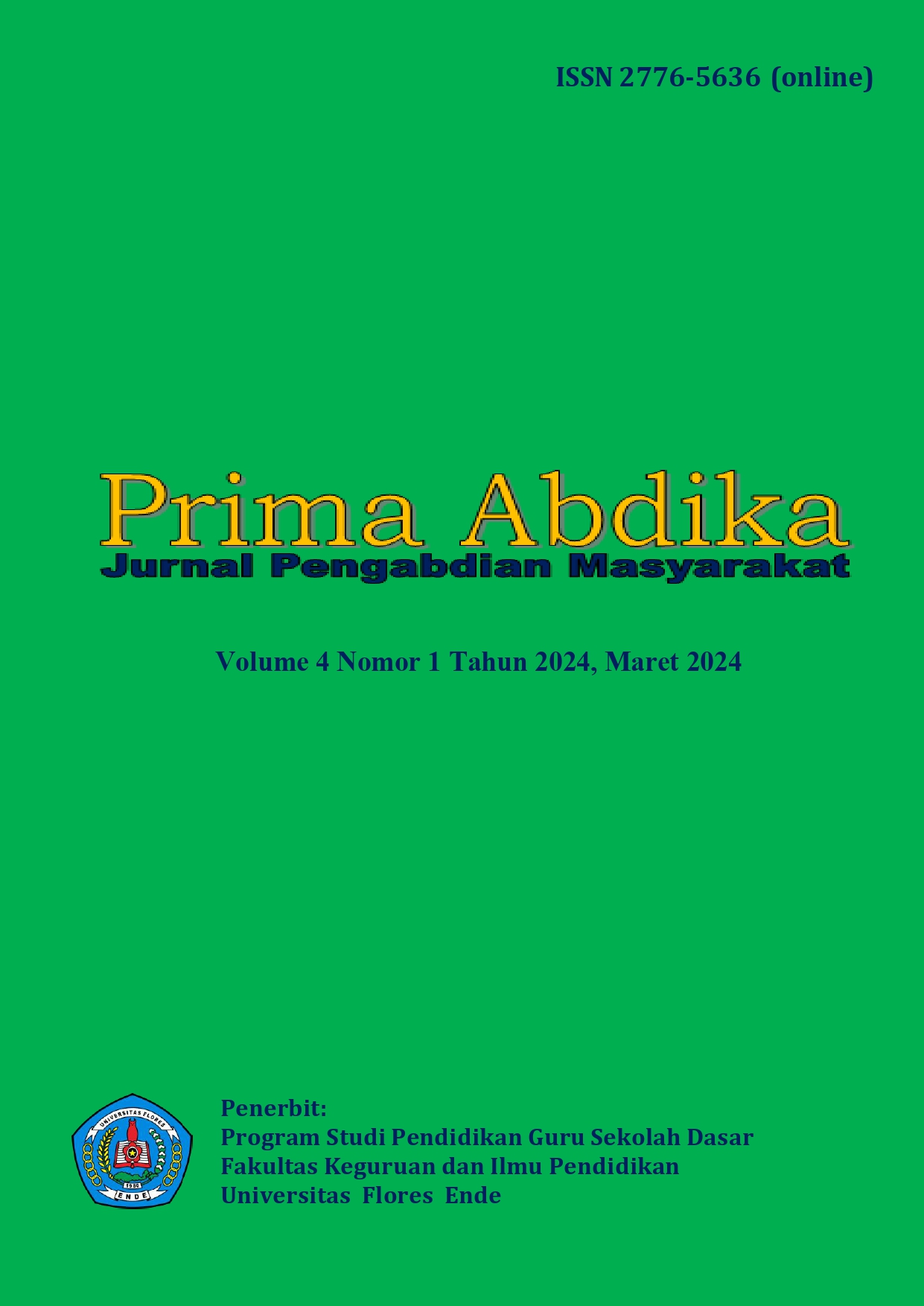Animasi Kitab Suci sebagai Upaya Meningkatkan Kecintaan Anak dan Remaja terhadap Kitab Suci
DOI:
https://doi.org/10.37478/abdika.v4i1.3804Abstract
One of the concerns raised in the pastoral panorama during the Eighth Pastoral Assembly (Muspas) of the Archdiocese of Ende is the lack of interest among children and teenagers in activities related to the Holy Scriptures. This reality is also keenly felt in the pastoral work of the Quasi-Parish of St. Charles Borromeo in Orakeri. Generally, Catholic children and teenagers lack enthusiasm and quickly become bored with Sekami activities that are too monotonous and lacking in variety. Furthermore, the limited number of competent leaders at the parish level and the lack of knowledge about the Scriptures contribute to the decreasing interest and affection of children and teenagers towards the Holy Scriptures. This service activity is conducted for the target groups of Catholic children and teenagers in the Quasi-Parish of St. Charles Borromeo in Orakeri Ende. The main objective is to enrich knowledge about the Holy Scriptures, hone skills in relation to Scripture literacy, and enhance the love of children and teenagers for the Holy Scriptures. The method used in this activity is a qualitative method that involves participatory action research in the form of lectures and simple yet meaningful practices, involving many participants. Activities include: introducing the Holy Scriptures with the help of cheers, movements, songs, and animated videos; Scripture literacy through training in reading and speaking the Scriptures, composing scripts and dramatizing the Scriptures, as well as various competitions related to the Scriptures. This combination of methods is aimed at minimizing participant boredom while simultaneously encouraging the development of cognitive, affective, and psychomotor aspects among the participants. Consequently, the results achieved are that Catholic children and teenagers have a deeper understanding of the Holy Scriptures, sharpen skills related to Scripture literacy, and grow in their love for the Holy Scriptures.
Downloads
Keywords:
Animation, Holy Bible, Love, Children and TeenagersReferences
Achituv, S. & Lichtenstein, R.D. (2023). "Which of the Bible Stories Do You Best Remember? The Significance of Selected Bible Stories for Early Childhood Education Students". British Journal of Religious Education. Vol. 45, 2023– Issue 2, 186-199. https://doi.org/10.1080/01416200.2022.2061423.
Alliston, R. (2005). Gaya Bercerita yang Efektif. Jakarta: Prestasi Pustakaraya.
Barus, A., Wuysang, H. & Panjaitan, R. (2015). Panduan Pelatihan Baca Gali Alkitab. Jakarta: Scripture Union Indonesia.
Bhodo, Y. D. dan Kemba, M. G. (2019). "Studi Tentang Metode Animasi Kitab Suci bagi Kelompok Jadi Pendamping Adik (JPA) Paroki St. Magdalena Sophia Barat" (Laporan Penelitian Stipar Ende).
Bisoli, C. (2000). L’Animatore Biblico. Identita, Competenze, Formazione. Torino: Elledici.
Coldron, J., and R. Smith. (1999). "Active Location in Teachers’ Construction of Their Professional Identities". Journal of Curriculum Studies 31 (6): 711–726. doi:10.1080/002202799182954.
Elkad-Lehman, I. (2009). "The Way a Teacher Exposes Kindergarten Children to Stories Is the Way She Connects, Loves and Exposed to This Domain". Sifrut Yeladim Venoar 130: 15–39.
Foti, P. (2020). "The Effects of Music and Creativity on Child’s Development an Innovative Educational Program". International Journal of Latest Research in Humanities and Social Science (IJLRHSS) Volume 03 - Issue 01, 01-09.
Hardawiryana, R. (penterj). (1997). Dokumen Konsili Vatikan II. Jakarta: Dokpen KWI.
Hutahaean, H., Sefendi, S., & Sinaga, L. (2021). "Edukasi Literasi Terhadap Warga Binaan Pemasyarakatan Membaca dan Memahami Kitab Suci". Jurnal Inovasi Hasil Pengabdian Masyarakat (JIPEMAS), 4(2), 199–208. https://doi.org/10.33474/jipemas.v4i2.9240
Jatmiko, N. (2017). "Kitab Suci sebagai Sumber Kehidupan Iman Keluarga". KOMUNIKASI - Majalah Keuskupan Bandung No. 443 September 2017, 4-5.
Landrum, R. E., Brakke, K., & McCarthy, M. A. (2019). "The Pedagogical Power of Storytelling". Scholarship of Teaching and Learning in Psychology, 5 (3), 247–253. https://doi.org/10.1037/stl0000152.
Lembaga Alkitab Indonesia. (1994). Kabar Baik Untuk Anak-Anak. Alkitab Pertama Yang Kumiliki. Jakarta: LAI.
Lembaga Alkitab Indonesia. (2012). Alkitab Edisi Studi. Jakarta: LAI.
Long, T. G. (1989). Preaching and the Literary Forms of the Bible. Philadelphia: Fortress Press.
Mala, M. Y. (2018). "Meningkatkan Minat Anak-Anak Terhadap Kitab Suci Melalui Metode Cerita (Studi Lapangan di Kalangan Siswa-Siswi Kelas V SDI Paga)". Skripsi. Stipar Ende, 2018.
Mangunwijaya, Y.B. (2020). Menumbuhkan Sikap Religius Anak-Anak. Jakarta: Kompas.
Marsunu, S. dan Jap Fu Lap. (2007). Lima Harta dalam Lima Cerita. Jakarta: Komisi Kateketik KAJ.
Pa, P. (2000). "Kerasulan Kitab Suci bagi Anak-Anak" (makalah seminar) Biro Nasional KKI Jakarta.
Purnomo, A. & Hadianto, J. (eds.) (2022). Sabda Allah di Bumi Pertiwi. Sejarah Lembaga Biblika Indonesia dan Panorama Kerasulan Kitab Suci Gereja Katolik Indonesia. Jakarta: Obor.
Purnomo, A. & Hadianto, J. (eds.) (2023). Kerasulan Kitab Suci – Sebuah Panduan. Jakarta: Obor.
Ruiz, G. A. (2017). "Examining the Role of the Reader: A Necessary Task for Catholic Biblical Interpretation". Horizons, 44 (1), 28–55. https://doi.org/10.1017/hor.2017.1
Shkedi, A., and M. Nisan. (2009). “The Influence of Teachers’ Personal Ideology on Ways of Teaching the Bible.” Theory and Practice in Curriculum Planning 20: 53–77.
Silaban, B. B. H., & Hutahaean, H. (2020). Model Pembinaan Remaja Di Era Pandemik Dengan Pendalaman Alkitab BGA. Jurnal PKM Setiadharma, 1(3), 53–58. https://doi.org/10.47457/jps.v1i3.106.
Suharyo, I. (1991). Pemahaman Dasar Kitab Suci. Yogyakarta: Kanisius.
Suparman, M. (2019). "Remajapun Mampu Mewartakan Injil". dalam KOMUNIKASI Majalah Keuskupan Bandung. No. 465 Juli 2019. 4-6.
Surip, S. (2010). Bimbing Anak Cinta Alkitab. Yogyakarta: Kanisius.
Susanto, Y. F. (2018). "Kitab Suci itu Asyik". HIDUP No. 35, 2 September 2018.
Triyono, S. (2019). "Firman Allah di Zaman Yang Berubah". Warta SUMBER HIDUP Vol. 22 No. 1, Juni-September 2019.
Wijaya, S. (2018). "Kerasulan Kitab Suci" dalam: Buletin PASS (Paroki St. Theresia Jakarta) Edisi Mei 2018.
Yaumi, M. & Damopolil, M. (2014). Action Research: Teori, Model, & Aplikasi. Jakarta: Kencana.
Downloads
Published
How to Cite
Issue
Section
License
Copyright (c) 2024 Yohanes Donbosko Bhodo, Damianus Dionisius Nuwa, Primiaty Natalia Sabu Kopong, Maria Anjelita Biru, Maria Magdalena Bida, Maria Magdalena Lendu, Margaretha Apriliani Wuda

This work is licensed under a Creative Commons Attribution-ShareAlike 4.0 International License.




